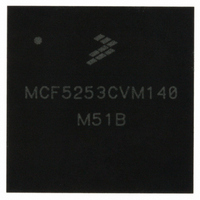MCF5253CVM140 Freescale Semiconductor, MCF5253CVM140 Datasheet - Page 530

MCF5253CVM140
Manufacturer Part Number
MCF5253CVM140
Description
IC MPU 32BIT 140MHZ 225-MAPBGA
Manufacturer
Freescale Semiconductor
Series
MCF525xr
Datasheets
1.MCF5253VM140J.pdf
(34 pages)
2.MCF5253VM140J.pdf
(8 pages)
3.MCF5253VM140J.pdf
(648 pages)
4.MCF5253VM140J.pdf
(2 pages)
Specifications of MCF5253CVM140
Core Processor
Coldfire V2
Core Size
32-Bit
Speed
140MHz
Connectivity
CAN, EBI/EMI, I²C, QSPI, UART/USART, USB OTG
Peripherals
DMA, WDT
Program Memory Type
ROMless
Ram Size
128K x 8
Voltage - Supply (vcc/vdd)
1.08 V ~ 1.32 V
Data Converters
A/D 6x12b
Oscillator Type
External
Operating Temperature
-40°C ~ 85°C
Package / Case
225-MAPBGA
Family Name
MCF5xxx
Device Core
ColdFire V2
Device Core Size
32b
Frequency (max)
140MHz
Instruction Set Architecture
RISC
Supply Voltage 1 (typ)
1.2/3.3V
Operating Supply Voltage (max)
1.32/3.6V
Operating Supply Voltage (min)
1.08/3V
Operating Temp Range
-40C to 85C
Operating Temperature Classification
Industrial
Mounting
Surface Mount
Pin Count
225
Package Type
MA-BGA
Lead Free Status / RoHS Status
Lead free / RoHS Compliant
Number Of I /o
-
Eeprom Size
-
Program Memory Size
-
Lead Free Status / Rohs Status
Compliant
Available stocks
Company
Part Number
Manufacturer
Quantity
Price
Company:
Part Number:
MCF5253CVM140
Manufacturer:
FREESCALE
Quantity:
300
Company:
Part Number:
MCF5253CVM140
Manufacturer:
Freescale Semiconductor
Quantity:
10 000
Part Number:
MCF5253CVM140
Manufacturer:
FREESCALE
Quantity:
20 000
Company:
Part Number:
MCF5253CVM140J
Manufacturer:
Freescale Semiconductor
Quantity:
10 000
- MCF5253VM140J PDF datasheet
- MCF5253VM140J PDF datasheet #2
- MCF5253VM140J PDF datasheet #3
- MCF5253VM140J PDF datasheet #4
- Current page: 530 of 648
- Download datasheet (8Mb)
Universal Serial Bus Interface
In order to communicate with devices via the asynchronous schedule, the system software must write the
ASYNDLISTADDR register with the address of a control or bulk queue head. The software must then
enable the asynchronous schedule by writing a one to the Asynchronous Schedule Enable bit in the
USBCMD register. In order to communicate with devices via the periodic schedule, the system software
must enable the periodic schedule by writing a one to the Periodic Schedule Enable bit in the USBCMD
register. Note that the schedules can be turned on before the first port is reset (and enabled).
Any time the USBCMD register is written, the system software must ensure the appropriate bits are
preserved, depending on the intended operation.
24.9.2
The Port Power Control (PPC) bit in the HCSPARAMS register indicates whether the USB 2.0 host
controller has port power control. When the PPC bit is a one, then the host controller supports port power
switches. Each available switch has an output enable. PPE is controlled based on the state of the
combination bits PPC bit, EHCI Configured (CF)-bit and individual Port Power (PP) bits.
24.9.3
Host ports by definition are power providers on USB. Whether the ports are considered high- or
low-powered is a platform implementation issue. Each EHCI PORTSC register has an over-current status
and over-current change bit. The functionality of these bits is specified in the USB Specification
Revision 2.0.
In this implementation, however, over-current is not reported to the USB core. Therefore the bits:
Over-current Active and Over-current Change in the PORTSC register will be static. The over-current
detection and limiting logic resides outside the MCF5253. The USB software stack is responsible for
monitoring the Over-current condition on the external device.
24.9.4
The host controller provides an equivalent suspend and resume model as that defined for individual ports
in a USB 2.0 hub. Control mechanisms are provided to allow the system software to suspend and resume
individual ports. The mechanisms allow the individual ports to be resumed completely via software
initiation. Other control mechanisms are provided to parameterize the host controller's response (or
sensitivity) to external resume events. In this discussion, host-initiated, or software-initiated resumes are
called Resume Events/Actions; bus-initiated resume events are called wake-up events. The classes of
wakeup events are:
Selective suspend is a feature supported by the PORTSC register. It is used to place specific ports into a
suspend mode. This feature is used as a functional component for implementing the appropriate power
24-68
•
•
Remote-wakeup enabled device asserts resume signaling. In similar kind to USB 2.0 hubs, when
in host mode the host controller responds to explicit device resume signaling and wake up the
system (if necessary).
Port connect and disconnect. Sensitivity to these events can be turned on or off by using the port
control bits in the PORTSC register. An Over-current event will not wake the USB core.
Power Port
Reporting Over-Current
Suspend/Resume
MCF5253 Reference Manual, Rev. 1
Freescale Semiconductor
Related parts for MCF5253CVM140
Image
Part Number
Description
Manufacturer
Datasheet
Request
R
Part Number:
Description:
Mcf5253 Coldfire? Microprocessor Data Sheet
Manufacturer:
Freescale Semiconductor, Inc
Datasheet:
Part Number:
Description:
Manufacturer:
Freescale Semiconductor, Inc
Datasheet:
Part Number:
Description:
Manufacturer:
Freescale Semiconductor, Inc
Datasheet:
Part Number:
Description:
Manufacturer:
Freescale Semiconductor, Inc
Datasheet:
Part Number:
Description:
Manufacturer:
Freescale Semiconductor, Inc
Datasheet:
Part Number:
Description:
Manufacturer:
Freescale Semiconductor, Inc
Datasheet:
Part Number:
Description:
Manufacturer:
Freescale Semiconductor, Inc
Datasheet:
Part Number:
Description:
Manufacturer:
Freescale Semiconductor, Inc
Datasheet:
Part Number:
Description:
Manufacturer:
Freescale Semiconductor, Inc
Datasheet:
Part Number:
Description:
Manufacturer:
Freescale Semiconductor, Inc
Datasheet:
Part Number:
Description:
Manufacturer:
Freescale Semiconductor, Inc
Datasheet:
Part Number:
Description:
Manufacturer:
Freescale Semiconductor, Inc
Datasheet:
Part Number:
Description:
Manufacturer:
Freescale Semiconductor, Inc
Datasheet:
Part Number:
Description:
Manufacturer:
Freescale Semiconductor, Inc
Datasheet:
Part Number:
Description:
Manufacturer:
Freescale Semiconductor, Inc
Datasheet:











